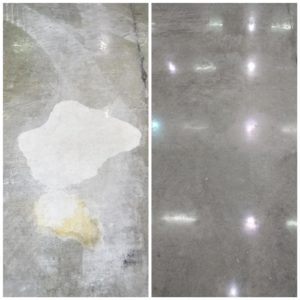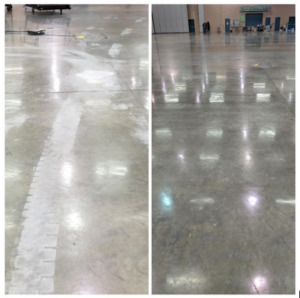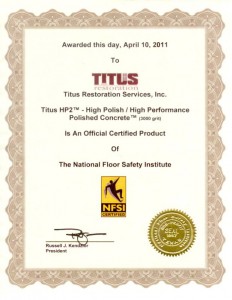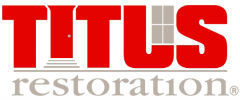It is possible to repair acid damaged concrete. Titus Restoration Services, Inc. has performed repairs to acid damaged concrete floors successfully as shown in the before and after pictures below. In 2017 we polished 144,000 square feet of a convention center. Within a month there was an auto show and acid was spilled on the finished polished concrete. Battery acid was spilled on the concrete floor and tracked throughout one of the exhibit halls (approximately 36,000 sf).


How Repairing Acid Damaged Polished Concrete is Performed
Polished concrete has become more popular in the last three decades in retail and municipal buildings due to its low maintenance costs. Due to its popularity and increased square footage installed throughout the world, acid damage to polished concrete has become more prevalent. A few building uses that have turned from carpet, vinyl tile (VCT) or other hard surface flooring to polished concrete include: grocery stores, schools, liquor stores, big box lumber companies, clothing stores, hardware stores, car dealerships, industries requiring dust free and easily cleaned floors, food warehouses, medical warehouses, and distribution centers, and even general warehouses.
Buildings Most Exposed to Acid Damaged Concrete
The polished concrete floors in some buildings are more susceptible to acid damage to their polished concrete floors than others. Some of the most susceptible floors are liquor stores, grocery stores, and automotive repair shops – or anywhere an acidic liquid could be spilled.
- In a liquor store, an accidentally broken bottle of red wine can damage a polished concrete floor. Wine has mild acidity and the red color makes the stain look worse. Since 2016 stain protection has been developed to protect against this hazard but the product must be allowed to dwell on the floor.
- In a grocery store, any acidic item spilled on the polished concrete could etch the polished finish. These include vinegar, pickle juice, wine, colas, etc. Here again, stain protection is now available for this potential hazard as the acids are mild.
- In an automotive shop, the hazard is battery acid. While the newest technology in polished concrete stain guards will protect against many oils, there is no current polished concrete protection for strong acids such as battery acid (sulfuric acid). Chemically resistant coatings can protect concrete floors from hydrochloric (muriatic) acid or other strong acids.
Understanding Acid Damaged Concrete
Whether it be polished concrete or the concrete floor of a warehouse, it is not possible to just follow the acid trails with a floor grinder and properly restore the floor. It is important to understand both the characteristics of concrete and acid. Concrete has a pH of 11 or higher and acids that are strong enough to damage it have a ph of 4 or lower. Upon contact, they are quite reactive but they seek equilibrium and soon they neutralize themselves. Based on this self-canceling reaction, it is more typical than not that the damage is located nearer the surface of the concrete rather than deep within the concrete.
The repair of acid damage to concrete should be left to an experienced professional, especially when aesthetics are important. It is very easy to use too aggressive diamond tooling and does irreparable harm to the aesthetics of the slab. The ability to skillfully blend is important and requires experience, yet is not always 100% possible. The restoration professional has to know when to stop grinding deeper and incurring more costs.
About Acid Damaged Concrete
The acid has eaten through the hard-cap of the concrete and the floor must be restored to prevent further erosion and dusting. Below is a more detailed explanation of the characteristics of a concrete slab along with some key points to consider when repairing acid damage on a concrete floor:
-
-
- When a concrete floor is poured, the concrete finishers use trowels to make it smooth. In a large warehouse, the trowels they use are typically a heavy ride on type with a combustion engine and steel smoothing blades.
-
- As the floor is troweled the finest particles come to the top (this is called the concrete cream), then below the concrete cream is sand, and below the sand is pea gravel and larger aggregates.
-
- As the concrete dries and moisture leaves the slab, capillaries of air are left in the concrete making it susceptible to moisture absorption.
-
- Because the fine particles (concrete cream) have risen to the top of the slab, the top of the slab is more dense and harder. Typically, multiple trowel passes are made during concrete placement to make the surface very slick and hard.
-
- Typically the concrete below the cream is a different color than the surface of the cream.
-
- Typically the cream will have a Mohs hardness of 4-6.
-
- Typically, once the cream is gone, the Mohs hardness will drop 1-2 points to a 3-5.
- Contractors who are experienced in concrete grinding, honing, and resurfacing will use different diamonds, multiple passes, and special reactive liquid silicate concrete hardening chemicals to restore the surface of the concrete to as close to the original Mohs hardness as possible.
-
- Typically the concrete below the cream is a different color than the surface of the cream.
-
- Because the fine particles (concrete cream) have risen to the top of the slab, the top of the slab is more dense and harder. Typically, multiple trowel passes are made during concrete placement to make the surface very slick and hard.
-
- For decades concrete warehouse floors have been chemically treated to prevent dusting. This is a one-time treatment that reacts with the free lime in the concrete to harden it and prevent dusting.
-
- Based on Titus’ 15 years of experience as a concrete restoration specialist (and 49 years experience in concrete coatings), this acid has penetrated through this chemically hardened concrete layer and the damaged areas are softer and will dust more easily.
-
- This acid has damaged the cement paste, not the sand or aggregates. Microscopically, acid etched concrete would resemble a sponge as the acid travels through the capillaries of the concrete and dissolves the cement paste.
- The restoration process will require diamond grinding deep enough to remove the acid marks, which will, in turn, remove the top layer of concrete that has been treated for anti-dusting and hardening.
-
How to Repair Acid Damaged Concrete
-
- Determine the starting grit of diamond to remove the acid damage. Titus does this with a variable speed wet hand grinder or a three-headed countertop polisher and diamond pads called electroplates.
- We will start with a fine grit and work our way to coarser grits to determine the proper starting grit.
- Titus lets the floor dry at each grit as a wet floor is very deceiving, it will hide any blemishes.
- Once the proper grit has been determined, we will apply all the chemicals and finish the test area. This is a slow process. Much time is spent waiting for the floor to dry. A heat gun or hair dryer will speed up this process. Count on 3 to 4 hours minimum to determine the starting diamond.
- Once the starting grit has been determined, wet diamond- grinding the floor to remove the damaged concrete begins. Wet grinding is a very important safety issue to Titus. It increases both personnel and building issues concerning silicosis.
- We proceed with multiple finer grit diamonds, decreasing the grit size with each pass, to eliminate visible scratches and keep the floor cleanable.
- We autoscrub the floor to remove the concrete slurry from the slab.
- Once the floor is clean and dry, it is then time to chemically re-harden and dust-proof the concrete floor. It important to keep the chemical wet 20 minutes and to apply the chemical to rejection. .
- Finally, remove excess chemical and re-autoscrub. The restoration is now complete.
- Burnishing the floor with a diamond impregnated pad is optional.Adding stainguard to the floor is optional. It increases gloss and makes the floor more cleanable, but it will not protect against harsh acids.
- If oil spills are a concern, please advise your contractor. Stain protection from oil is currently available.
- Determine the starting grit of diamond to remove the acid damage. Titus does this with a variable speed wet hand grinder or a three-headed countertop polisher and diamond pads called electroplates.
In conclusion, Titus’ goal is to restore the floor to as close to its original state as possible. Please note the following clarifications:
-
- From observing the surface, it is impossible to tell how deep the acid has penetrated the concrete. It may not be possible to remove the light color of the acid marks completely. We have included pictures of recent work – there is a very faint discoloration in some areas.
- Titus will start the restoration process using the least invasive wet diamond grinding process as possible.
- The floor may contain discoloration after restoration. This is because:
-
-
- Until grinding begins, it is impossible to know the depth of acid damage. This would vary based on many things, including the amount and concentration of acid spilled in any given area.
-
- The depth of the cream and if the acid damage went through the cream.
- The color of the concrete below the cream.
-
Titus will perform the restoration of an acid-damaged floor with utmost care in order to return to you a concrete floor that is functional in terms of hardness and anti-dusting, and free of acid marks.

HP2 Certificate
